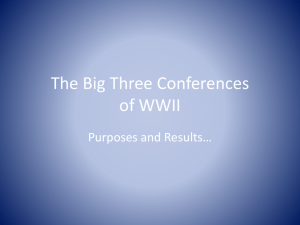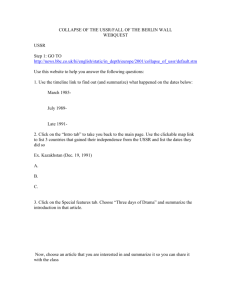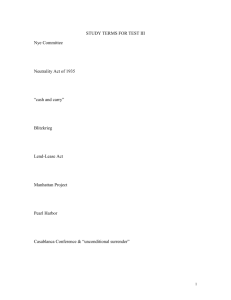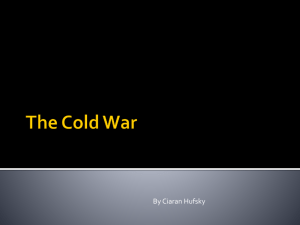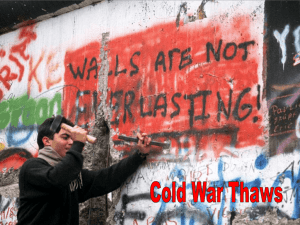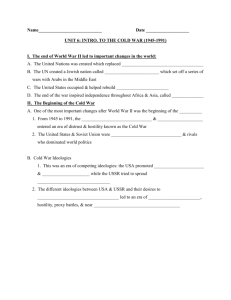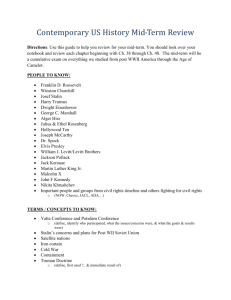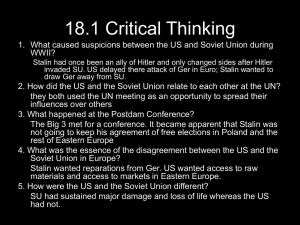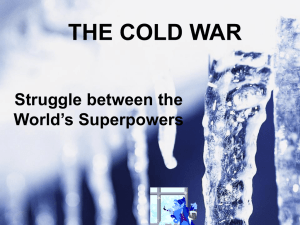cold war paper 2 review - IB 20th c. World History Y2
advertisement
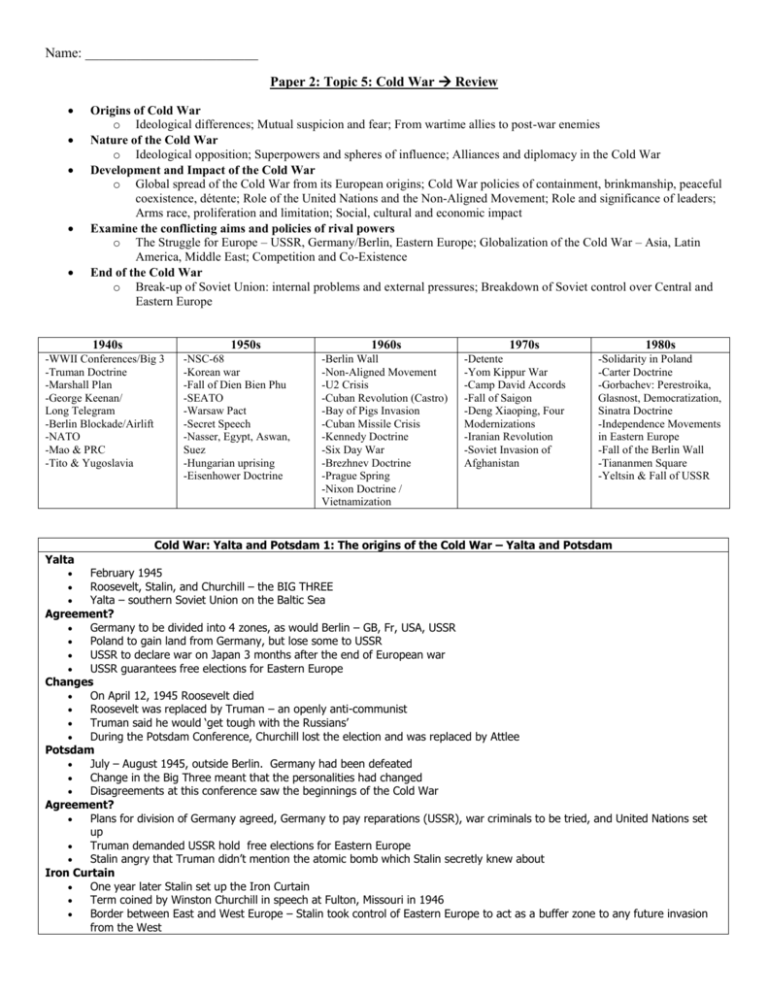
Name: _________________________ Paper 2: Topic 5: Cold War Review Origins of Cold War o Ideological differences; Mutual suspicion and fear; From wartime allies to post-war enemies Nature of the Cold War o Ideological opposition; Superpowers and spheres of influence; Alliances and diplomacy in the Cold War Development and Impact of the Cold War o Global spread of the Cold War from its European origins; Cold War policies of containment, brinkmanship, peaceful coexistence, détente; Role of the United Nations and the Non-Aligned Movement; Role and significance of leaders; Arms race, proliferation and limitation; Social, cultural and economic impact Examine the conflicting aims and policies of rival powers o The Struggle for Europe – USSR, Germany/Berlin, Eastern Europe; Globalization of the Cold War – Asia, Latin America, Middle East; Competition and Co-Existence End of the Cold War o Break-up of Soviet Union: internal problems and external pressures; Breakdown of Soviet control over Central and Eastern Europe 1940s 1950s -WWII Conferences/Big 3 -Truman Doctrine -Marshall Plan -George Keenan/ Long Telegram -Berlin Blockade/Airlift -NATO -Mao & PRC -Tito & Yugoslavia -NSC-68 -Korean war -Fall of Dien Bien Phu -SEATO -Warsaw Pact -Secret Speech -Nasser, Egypt, Aswan, Suez -Hungarian uprising -Eisenhower Doctrine 1960s -Berlin Wall -Non-Aligned Movement -U2 Crisis -Cuban Revolution (Castro) -Bay of Pigs Invasion -Cuban Missile Crisis -Kennedy Doctrine -Six Day War -Brezhnev Doctrine -Prague Spring -Nixon Doctrine / Vietnamization 1970s -Detente -Yom Kippur War -Camp David Accords -Fall of Saigon -Deng Xiaoping, Four Modernizations -Iranian Revolution -Soviet Invasion of Afghanistan 1980s -Solidarity in Poland -Carter Doctrine -Gorbachev: Perestroika, Glasnost, Democratization, Sinatra Doctrine -Independence Movements in Eastern Europe -Fall of the Berlin Wall -Tiananmen Square -Yeltsin & Fall of USSR Cold War: Yalta and Potsdam 1: The origins of the Cold War – Yalta and Potsdam Yalta February 1945 Roosevelt, Stalin, and Churchill – the BIG THREE Yalta – southern Soviet Union on the Baltic Sea Agreement? Germany to be divided into 4 zones, as would Berlin – GB, Fr, USA, USSR Poland to gain land from Germany, but lose some to USSR USSR to declare war on Japan 3 months after the end of European war USSR guarantees free elections for Eastern Europe Changes On April 12, 1945 Roosevelt died Roosevelt was replaced by Truman – an openly anti-communist Truman said he would ‘get tough with the Russians’ During the Potsdam Conference, Churchill lost the election and was replaced by Attlee Potsdam July – August 1945, outside Berlin. Germany had been defeated Change in the Big Three meant that the personalities had changed Disagreements at this conference saw the beginnings of the Cold War Agreement? Plans for division of Germany agreed, Germany to pay reparations (USSR), war criminals to be tried, and United Nations set up Truman demanded USSR hold free elections for Eastern Europe Stalin angry that Truman didn’t mention the atomic bomb which Stalin secretly knew about Iron Curtain One year later Stalin set up the Iron Curtain Term coined by Winston Churchill in speech at Fulton, Missouri in 1946 Border between East and West Europe – Stalin took control of Eastern Europe to act as a buffer zone to any future invasion from the West The Cold War (in great detail) 1929: Great Depression 1930s: Rise of Totalitarian Dictators (Single-Party States) & Appeasement World War II: 1939-1945 Big 3 @ Tehran, Yalta, and Potsdam Conferences Truman Doctrine George Keenan, Long Telegram & Article X in Foreign 1947 Marshall Plan 1948 Affairs 1947 NATO 1949 NSC-68 1950 Warsaw Pact 1955 Policy of providing economic and military aid to any country threatened by communism or totalitarian ideology State Department official Called for a policy of containment toward the Soviet Union & est. the foundation for much of America's early Cold War foreign policy Popularized the term "containment" U.S. Secretary of State George C. Marshall (Speech at Harvard, June 1947) Economic Assistance Act Help the nations of Europe recover and rebuild after the devastation wrought by World War II (and counter forces of communism) $13 billion in aid over four years (1948-51) North Atlantic Treaty Organization USA, Canada, and Western Europe Collective security against the Soviet aggression National Security Council Paper NSC-68 "United States Objectives and Programs for National Security" Rejected isolationism Called for a build-up of the U.S. military and its weaponry (conventional & nuclear) 1948-1949 Berlin Crisis = Berlin Blockade and Berlin Airlift US Occupation of Japan: 1945-1952 Establishment of the People’s Republic of China: 1949 (Mao, CCP, PLA) Korean War: 1950-1953 Fall of Dien Bien Phu (French Indochina): 1954 Southeast Asian Treaty Organization (SEATO): 1954 Treaty on Friendship, Cooperation, and Mutual Assistance Soviet-led political-military alliance in Eastern Europe Counterweight to NATO Speech during closed session of Communist Party Denunciation of Stalin’s policies De-Stalinization campaign Idealized Leninist Model Any country could request American economic assistance and/or aid from U.S. military forces if it was being threatened by armed aggression from another state Motivated in part by an increase in Arab hostility toward the West, and growing Soviet influence in Egypt and Syria Vietnam War: 1955-1975 Bandung Conference: 1955 (precursor to Non-Aligned Movement) Nasser: Aswan Dam, Nationalization of Suez Canal, Suez Crisis: 1956 (Sevres Protocol, UK/France/Israel) Hungarian Revolution: 1956 (crushed by Soviet troops) Khrushchev’s Secret Speech 1956 Eisenhower Doctrine 1957 (Suez Crisis) Berlin Crisis 1958-1961 / Construction of the Berlin Wall U2 Crisis: 1960- Francis Gary Powers Kennedy Doctrine Johnson Doctrine 1962 1965 Cuban Revolution: 1959 Bay of Pigs Invasion (fail): 1961 Cuban Missile Crisis: 1962 Formation of the Non-Aligned Movement: 1961 (Egypt/Nasser, Ghana/Nkrumah, India/Nehru, Indonesia/ Sukarno, Yugoslavia/Tito,) Cold War containment Focus on Latin America "Pay any price, bear any burden" Domestic revolution in the Western Hemisphere would no longer be a local matter when "the object is the establishment of a Communist dictatorship" (extension of Kennedy Doctrine) Détente: 1960s & 1970s (Limited Test Ban Treaty, SALT I, ABM Treaty, Helsinki Accords) Six Day War: 1967, UNSC Resolution 242 Prague Spring (Czechoslovakia):1968 Brezhnev Doctrine 1968 Nixon Doctrine 1969 USSR’s policy of combating "anti-socialist forces" U.S. would use military force if necessary to defend its national interests in the Persian Gulf region Glasnost Openness in politics and government (eliminate corruption & gerontocracy) Perestroika Restructuring of the economy Democratization See Sinatra Doctrine Policy of allowing neighboring Warsaw Pact nations to determine their own internal affairs “The sovereignty of each socialist country cannot be opposed to the interests of the world of socialism” US expects its Asian allies to tend to their own military defense “Vietnamization” Yom Kippur War: 1973, UNSC Resolution 338, Geneva Conference 1973, Camp David Accords 1978 Fall of Saigon: 1975, Deng Xiaoping begins Four Modernizations: 1978 Iranian Revolution: 1979, Soviet Afghan War: 1979-1989 (1980 & 1984 Olympic Boycotts) Solidarity Movement in Poland: 1980s (Lech Walesa, Pope John Paul II) Carter Doctrine, NSC-63 Policies of Mikhail Gorbachev Sinatra Doctrine/My Way 1980 1980s 1989 Independence Movements in Eastern Europe: 1989-1991 Fall of the Berlin Wall: 1989 Tiananmen Square Protests and Massacre: 1989 Collapse of the Soviet Union 1991 (Commonwealth of Independent States: CIS, Boris Yeltsin) Cold War: The USA versus USSR: What were the Ideological Differences Between America and Russia in 1945? Capitalism v Communism Businesses / farms owned by private people Profit is good – a reward for risk-bearing VERSUS Businesses and farms owned by the state and… …run by the government for the benefit of all people Profit is a form of oppression Democracy v Dictatorship Multi-party system Free elections Parliament (UK) / Congress (USA) make the laws – separate executive and legislative branches VERSUS Elections to the ‘Soviets’ One party only – the Communist party which… …rules the country Stalin de facto (in fact) an absolute dictator Freedom v Human Rights ‘His Majesty’s Opposition’ – minority party in UK Protests and demonstrations Human rights respected in law VERSUS Dissidents imprisoned KGB arrest grumblers The gulag Free Market v Command Economy Laws of supply and demand control production Competition keeps prices low and quality up – the weak go out of business Strikes and unemployment Freedom of choice VERSUS Workers ordered to a job / area Wages and hours fixed by law No unemployment – everyone has a job Equal Opportunity v Equality Everyone has a chance to succeed Consumer economy Great differences in wealth and class – millionaires v poverty Private medicine, houses, etc (health care is very good, but very expensive) VERSUS Poor standard of living – ‘producer’ goods (goods made are good for the producer, not necessarily good for the consumer) / empty shops Fewer very poor people Free health care / state-provided housing (health care is poor, but available to everyone) Free Press v Censorship Freedom of speech Newspapers, books, radio / tv / films not censored Media openly criticize government (Washington Post , New York Times) VERSUS No freedom of speech The media are owned and run by the government Censorship and propaganda (Pravda, Izvestia) Berlin Blockade 1948: Why did the Blockade happen and what were the Consequences? The Berlin Wall 1961: How Significant was the Berlin Wall and Why was it Built? Yalta Background Had been agreed to split Germany into four zones between USSR, France, Britain and USA. Berlin was similarly divided In 1948 USA, Britain and France merged their zones into West Germany and West Berlin USA poured large sums of money into West Berlin Background At Yalta, Berlin had been divided into four zones (just as Germany had been) In 1948-49, the Berlin Blockade saw Stalin attempt to ‘starve’ West Berlin into submission Stalin was forced to back down following the Berlin Airlift Stalin’s Concerns Stalin was convinced this was a capitalist plot to lure East Germans and East Berliners He was angry that he wasn’t consulted about decisions – such as the new Deutschmark Stalin may have thought the US and its allies were planning to reunite Germany Differences Apart from the Berlin Blockade, those living in Berlin could travel freely – live in the East and work in the West and vice versa Khrushchev proclaimed that Berlin was being used by the West as a base for spying and sabotage Stalin’s Reaction June 24, 1948 Stalin ordered all road, rail and canal routes between West Germany and West Berlin to be closed He hoped to force the US and her allies into submission US reacted strongly, claiming this was Stalin’s first step in a take-over of Western Europe Allied Reaction The Allies didn’t want to force their way into Berlin for fear of sparking a war, so they began to fly supplies in Flights began on June 26, reaching a peak of one every 3 minutes by September 1948 Consequences for USSR Stalin couldn’t just shoot the planes down He had to eventually back down – on May 12, 1949 he ended the blockade – it was a major embarrassment Stalin realized the USSR needed the atom bomb to stand up to the US. Atomic testing was increased Consequences for USA Seen as ‘proof’ that the USSR had plans to take over Europe NATO (North Atlantic Treaty Organization) formed in April 1949 as a result Stalin saw this as a deliberate threat In 1955 when West Germany joined NATO, the USSR-led ‘Warsaw Pact’ was formed Problems In reality, he wanted to prevent all the highly skilled and educated from working in West Berlin East Berlin was still suffering badly, whereas West Berlin was recovering well Between 1945-60 it is thought 3 million people crossed from East to West Berlin August 13, 1961 Overnight a well guarded fence was constructed dividing the city in two People were trapped in either East or West Berlin The fence was guarded by Red Army machine gun posts Concrete Wall By August 17th, the barbed wire fence was replaced with a concrete wall, split only by well guarded checkpoints From 1961 to 1989 nearly 90 people died trying to cross The wall became a symbol of the division between Communism and Capitalism Consequences In some ways it was a propaganda victory for the ‘West’ – they claimed Communist countries had to build a wall to imprison people However, there was very little the West could do to stop it – and the wall did serve its purpose Paper 2 - Topic 5 The Cold War – past exam questions 2011: “The Potsdam Conference marked the end of the wartime alliance and laid the foundations for post-war hostility.” With reference to the period up to 1949, to what extent do you agree with this statement? With reference to two countries, each chosen from a different region (excluding the US or the USSR), assess the social and economic impact of the Cold War. In what ways, and with what success, did the US and the USSR attempt to reduce Cold War tensions between 1956 and 1979? For what reasons, and with what results, did the Cold War affect the Middle East between 1956 and 1979? Compare and contrast the impact of two of the following leaders on the Cold War: Mao; Castro; Kennedy. To what extent did (a) ideological and (b) economic factors contribute to the ending of the Cold War? 2012: Assess the role of Truman and Stalin in the origins and development of the Cold War. “The sovietization of Eastern and Central Europe after the Second World War was undertaken as a defensive measure by the Soviet Union.” To what extent do you agree with this statement? Analyse the reasons for, and consequences of, the breakdown of Sino–Soviet relations in the 1950s and 1960s. Assess the economic and social impact of superpower involvement in one of the following: Cuba (after 1959); Congo (after 1960); Afghanistan (after 1979). In what ways, and with what significance, did either Kennedy or Reagan influence the development of the Cold War? For what reasons, and in what ways, did Cold War tensions hinder the work of the United Nations? 2013: “Post-war enmity was the product of longer term ideological differences.” To what extent do you agree with this statement on the origins of the Cold War up to 1949? For what reasons, and with what success, did the United States adopt a policy of containment between 1947 and 1962? Account for the change in Sino–Soviet relations after the death of Stalin in 1953. Assess the contribution of one of the following to the development of Cold War tensions: Truman; Mao; Castro. Analyse the reasons for, and results of, Soviet involvement in the war in Afghanistan (1979–1988). With reference to two states, each chosen from a different region, examine the cultural impact of the Cold War. 2014: “The Conferences of 1945 at Yalta and Potsdam marked both the high point and the breaking point of the wartime alliance of East and West.” To what extent do you agree with this statement? In What ways, and with what success, did the US attempt to prevent the global spread of Soviet influence between 1945 and 1962? Examine the social and economic impact of the Cold War on two states (excluding the US and USSR) each drawn from a different region. Assess the significance of events in either Korea (1950-1953) or the Congo (1960-1964) on the development of the Cold War. Examine the changing nature of US-Chinese relations between 1949 and 1972. Evaluate the role of internal problems in the break-up of the Soviet Union. Attacking the Paper 2 “Candidate performance in all essay responses could be improved significantly by taking time to plan the answer- where possible organising the response into suitable themes rather than producing narrative /descriptive accounts. Five to ten minutes drawing up an essay plan is time well spent despite what many candidates may think in their eagerness to address the question. … There is no substitute for sound knowledge, as this is the foundation of all good essays answers.” - MAY 2009 IB Subject Report Pre-writing: • 1. Select Task (Topic 3 & 5) Do you understand what you are being asked to do? Can you fully address this Task? 2. 5 Minutes to jot down ideas & groupings Key names, policies, dates, events, historiography 3. Develop Thesis Be Specific Address the task Explain WHY? Introduction & Thesis = 4-6 sentences at most Writing the Paper 2: Intro & Thesis – Strong, argumentative thesis (take a stand) – Address the task in its entirety – Can include some background • Body Paragraphs – Organized by argument or theme – Strong topic sentences – Historical vocabulary – ANALYSIS!!!! – Do not “name drop” historiography out of context – Avoid narration & description • Conclusion – Restate thesis – acknowledge limitations and counter-arguments “The best responses revealed command of chronology, task identification, structure and above all the provision of relevant historical detail. It cannot be emphasized enough that answers must be supported by reference to historical knowledge.” – May 2010, History Subject Report IB Markscheme: [0 to 7 marks] for inadequate/ general material [8 to 10 marks] for narrative with implicit analysis and assessment of methods and conditions for “rise to power” Implicit = implied, unspoken [11 to 13 marks] Meets 8-10 marks criteria AND… [14 to 16 marks] Meets 11-13 marks criteria AND… [17+ marks] Meets 14-16 marks criteria AND… for more exact focus and explicit assessment of methods used (e.g. why they succeeded) and conditions for “rise to power” for a structured, analytical response focused on methods and conditions for balance and an extra quality such as different interpretations (historiography) Explicit = overt, unambiguous Analytical = logical, systematic Extra Quality = Think AP Expanded Core Thesis, Multiple POVs, insight, comparison/ contrasts, synthesis… A Note on Historiography (as a component of the Paper 2 essay): If you cannot provide direct historiography, use indirect phrases such as … Historians have debated … or some historians suggest that … while others suggest that … This provides the examiner with the knowledge that you know historical debate exists.
